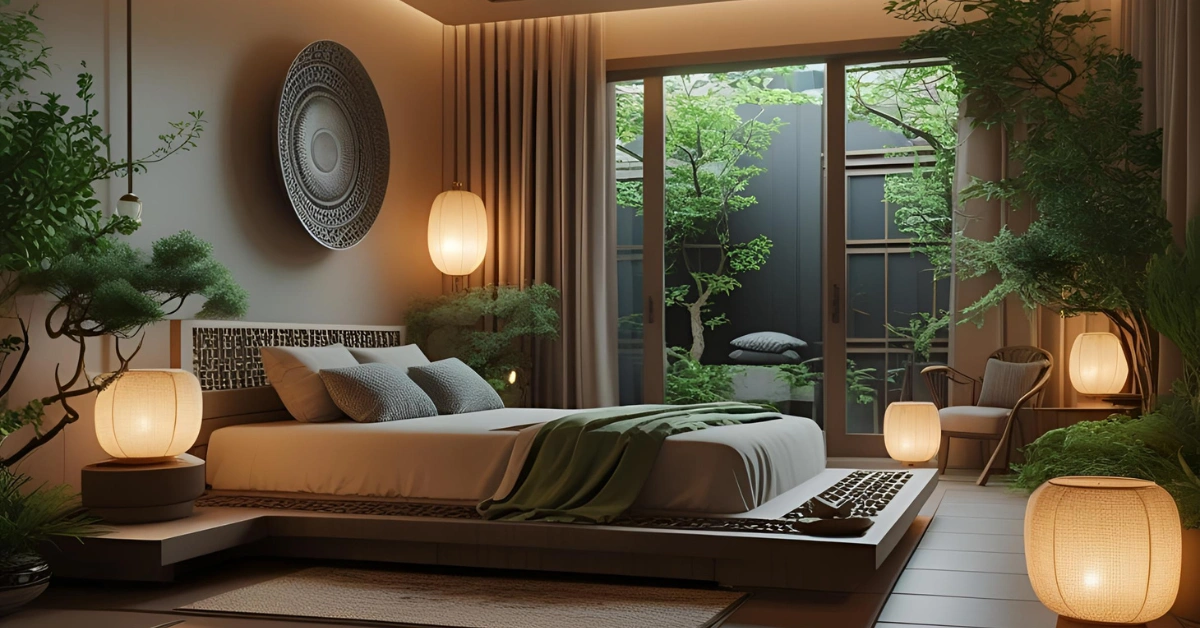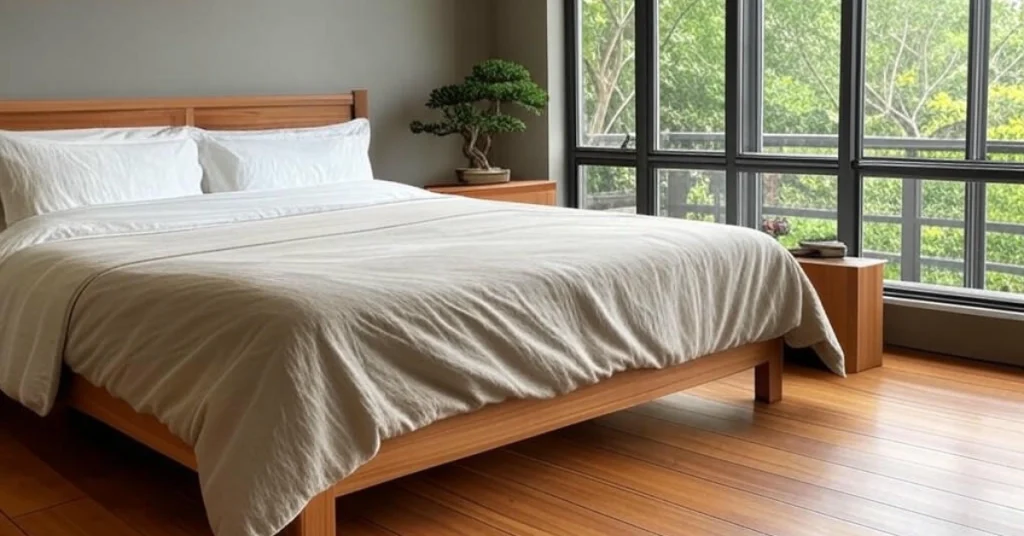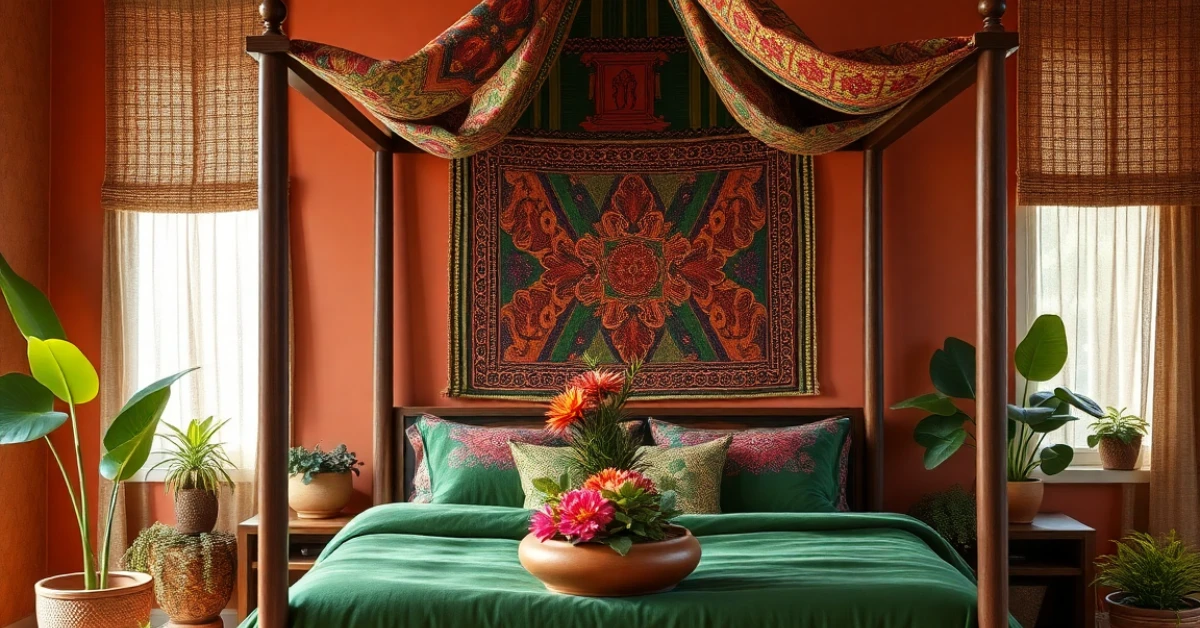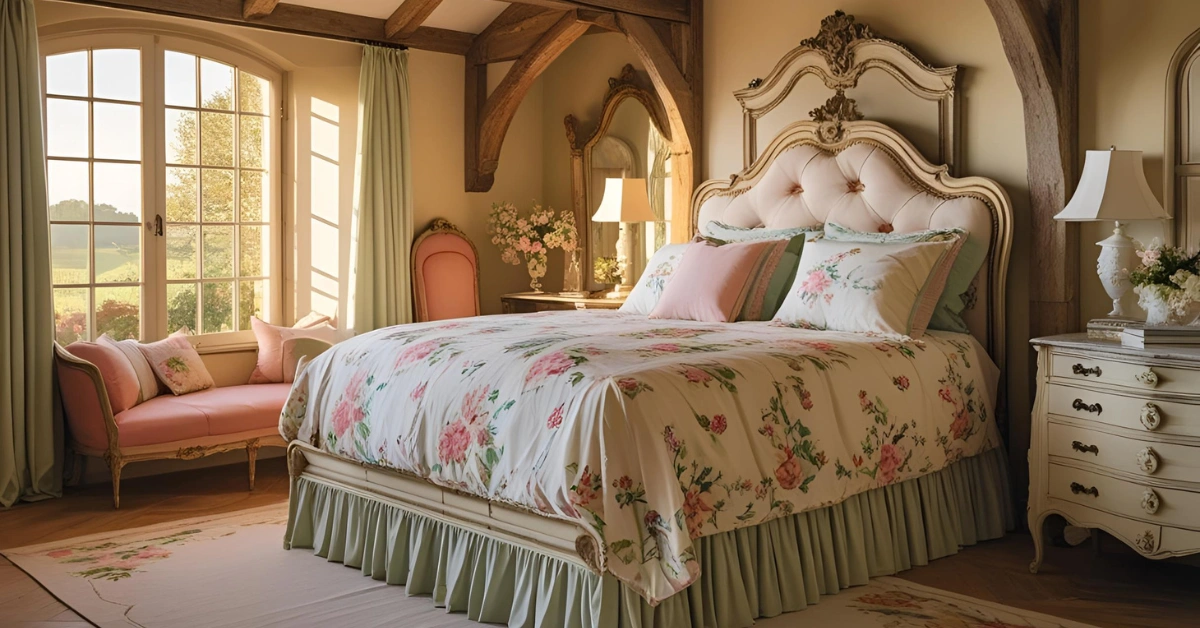Japandi Bedroom Designs: Crafting a Serene & Stylish Retreat

Japandi bedroom designs combine the minimalist elegance of Japanese aesthetics with the cozy functionality of Scandinavian style. This harmonious blend creates spaces that feel calm, uncluttered, and timeless. Whether you’re redesigning your bedroom or seeking fresh inspiration, Japandi offers a perfect balance of form and function. In this guide, we’ll explore the principles, elements, and practical tips to craft a Japandi-inspired bedroom that’s both beautiful and livable.

What Is Japandi Style?
The Origins of Japandi Design
Japandi is a hybrid interior design trend that merges Japanese and Scandinavian influences. Japanese design emphasizes simplicity, natural materials, and tranquility, rooted in the philosophy of wabi-sabi, which celebrates imperfection (The Spruce, 2023). Scandinavian design, or Nordic style, prioritizes functionality, clean lines, and coziness, often described as hygge. Together, they create a minimalist yet warm aesthetic that’s ideal for bedrooms.

Core Principles of Japandi Design
Japandi bedrooms are built on a few key principles:
- Minimalism: Focus on essentials, avoiding clutter.
- Natural Materials: Use wood, linen, cotton, and stone for authenticity.
- Neutral Palette: Embrace soft, earthy tones like beige, gray, and muted greens.
- Functionality: Every piece serves a purpose, blending beauty with utility.
- Balance: Combine sleek Japanese lines with Scandinavian warmth.
These principles make Japandi bedrooms serene retreats that promote rest and mindfulness.

Why Choose Japandi for Your Bedroom?
Benefits of a Japandi Bedroom
A Japandi bedroom offers more than just aesthetics. It creates a calming environment that supports relaxation and mental clarity. According to a 2022 study by the National Sleep Foundation, uncluttered spaces can improve sleep quality by reducing stress. The style’s emphasis on natural light and open space also enhances mood, making it ideal for modern living.

Who Should Consider Japandi?
This style suits anyone who values simplicity and tranquility. It’s perfect for:
- Urban dwellers seeking a peaceful escape.
- Minimalists who want a functional yet stylish space.
- Nature lovers drawn to organic materials and earthy tones.

Interior designer Aiko Tanaka notes, “Japandi is about creating a sanctuary where every element feels intentional, fostering a sense of calm that’s hard to find in busy lives.”
Key Elements of Japandi Bedroom Designs
1. Color Palette: Soft and Soothing
Japandi bedrooms rely on a neutral, earthy color scheme. Think warm beiges, soft grays, creamy whites, and muted greens or blues. These tones create a calming backdrop while allowing textures to shine. For example, a taupe wall paired with linen bedding adds depth without overwhelming the senses.

Tip: Use one accent color sparingly, like a charcoal throw or sage green pillow, to add subtle contrast.
2. Furniture: Simple and Functional
Furniture in Japandi bedrooms is low-profile and purposeful. Opt for:
- Low Platform Beds: Inspired by Japanese futons, these keep the room grounded.
- Wooden Pieces: Oak, walnut, or ash with clean lines and natural finishes.
- Multi-functional Items: A bedside table that doubles as storage.

Designer Lars Nilsson suggests, “Choose furniture that feels handcrafted. The imperfections in wood grain add character and align with wabi-sabi principles.”
3. Textures: Layering for Warmth
Textures are crucial in Japandi design to avoid a sterile look. Combine:
- Soft linens and cotton for bedding.
- Wool or jute rugs for warmth underfoot.
- Ceramic or stone accents for a tactile feel.

For instance, layering a linen duvet with a chunky knit throw creates a cozy yet refined look.
4. Lighting: Soft and Natural
Natural light is a cornerstone of Japandi design. Use sheer curtains to diffuse sunlight and create a soft glow. For evening lighting, choose:

- Paper lanterns or pendant lights with warm tones.
- Wooden table lamps with simple silhouettes.
- Candles for a hygge-inspired ambiance.
Example: In my friend’s Japandi bedroom, she installed bamboo blinds and a rice paper lamp, transforming the space into a serene haven.
5. Decor: Less Is More
Japandi decor is minimal but meaningful. Consider:
- A single piece of artwork, like a Japanese ink painting.
- Handmade ceramics or vases with organic shapes.
- Potted plants like bonsai or monstera for a touch of nature.

Avoid overcrowding surfaces. Each item should have breathing room to stand out.
How to Create a Japandi Bedroom: Step-by-Step Guide
Step 1: Declutter Your Space
Start by removing unnecessary items. Keep only essentials like your bed, nightstand, and a few decor pieces. A clutter-free room enhances the Japandi aesthetic and promotes calm. Marie Kondo’s principle of keeping items that “spark joy” aligns well here.

Step 2: Choose a Neutral Base
Paint walls in soft neutrals like ivory or light gray. For flooring, opt for natural wood or wood-look materials. A light oak floor, for example, complements both Japanese and Scandinavian influences.

Step 3: Select Japandi Furniture
Invest in a low platform bed with a wooden frame. Pair it with a minimalist nightstand and a small bench at the bed’s foot. Ensure every piece serves a purpose, like a dresser with hidden storage.

Step 4: Layer Textures and Fabrics
Add a linen duvet, cotton sheets, and a wool throw. Place a jute rug under the bed to anchor the space. These layers add warmth without compromising simplicity.

Step 5: Incorporate Natural Elements
Introduce plants like a fiddle-leaf fig or a small bonsai. Use wooden trays or stone coasters for small items. These elements bring the outdoors in, a key Japandi principle.

Step 6: Optimize Lighting
Maximize natural light with sheer curtains. Add a paper lantern or a wooden lamp for soft evening light. Avoid harsh overhead lighting, which disrupts the serene vibe.

Step 7: Add Thoughtful Decor
Choose one or two statement pieces, like a ceramic vase or a framed print. Keep surfaces clear to maintain the minimalist aesthetic. For example, a single bonsai on a nightstand can be a focal point.

Japandi Bedroom Design Ideas for Inspiration
1. Monochromatic Minimalism
Create a serene look with a monochromatic palette. Use shades of gray for walls, bedding, and rugs. Add a wooden bed frame and a single black-and-white artwork for contrast.

2. Nature-Inspired Retreat
Incorporate natural elements like a bamboo headboard, a jute rug, and potted plants. Use earthy tones like sage green and terracotta for bedding. This design feels like a forest escape.

3. Cozy Scandinavian Influence
Emphasize hygge with plush textures. Pair a low wooden bed with a chunky knit blanket and sheepskin throw. Add candles and a soft pendant light for warmth.

4. Zen Japanese Aesthetic
Focus on Japanese influences with a futon-style bed and sliding shoji screens. Use rice paper lamps and a single ink painting for decor. This creates a tranquil, Zen-like space.

5. Small-Space Japandi
For compact bedrooms, use multi-functional furniture like a storage bed or a foldable desk. Keep decor minimal and use light colors to make the space feel larger. A mirror with a wooden frame can add depth.
Common Mistakes to Avoid in Japandi Bedroom Designs
1. Overloading with Decor
Too many accessories disrupt the minimalist aesthetic. Stick to a few meaningful pieces. For example, one plant and one artwork are often enough.
2. Ignoring Functionality
Every item should serve a purpose. Avoid purely decorative furniture that crowds the space. A bench with storage, for instance, is both stylish and practical.
3. Using Harsh Colors
Bright or bold colors clash with Japandi’s calm vibe. Stick to neutrals and soft tones. If you want contrast, use muted shades like charcoal or olive.
4. Neglecting Texture Balance
Too many smooth surfaces can feel cold. Layer textures like linen, wool, and wood to add warmth. A smooth ceramic vase paired with a textured rug works well.
Japandi Bedroom Design on a Budget
You don’t need a big budget to create a Japandi bedroom. Here’s how:

- Shop Secondhand: Find wooden furniture at thrift stores or online marketplaces. Sand and refinish pieces for a natural look.
- DIY Decor: Make your own ceramic vases or frame simple prints. Use branches or driftwood as free natural accents.
- Affordable Textiles: Buy linen or cotton bedding from budget-friendly brands like IKEA or H&M Home.
- Repurpose Items: Use a wooden crate as a nightstand or stack books as a side table.
Example: I helped a friend transform her bedroom by repurposing an old wooden ladder into a towel rack, adding a Japandi touch for under $20.
Japandi vs. Other Bedroom Styles
| Style | Key Features | Best For |
|---|---|---|
| Japandi | Neutral tones, minimalism, natural materials | Those seeking calm and functionality |
| Bohemian | Vibrant colors, eclectic patterns | Creative, free-spirited individuals |
| Modern | Sleek lines, bold accents, high-tech | Urban, tech-savvy homeowners |
| Traditional | Ornate details, rich colors | Those who love classic elegance |
Japandi stands out for its balance of simplicity and warmth, making it versatile for various tastes.
Expert Tips for a Perfect Japandi Bedroom
Interior designer Hana Mori shares, “Incorporate wabi-sabi by choosing slightly imperfect pieces, like a hand-carved wooden stool. It adds soul to the space.” Other tips include:

- Use dimmable lights to adjust the mood.
- Keep bedding simple but layer textures for depth.
- Rotate decor seasonally to keep the space fresh.
Conclusion: Craft Your Dream Japandi Bedroom
Japandi bedroom designs offer a timeless way to create a serene, stylish retreat. By blending Japanese minimalism with Scandinavian warmth, you can craft a space that’s both functional and beautiful. Start with a neutral palette, add natural materials, and keep decor minimal yet meaningful. Ready to transform your bedroom? Explore Japandi-inspired furniture and textiles at local stores or online retailers like West Elm or CB2, and start designing your peaceful sanctuary today!






